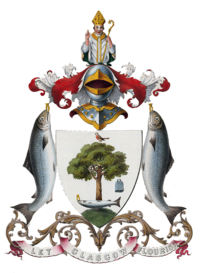Saint Kentigern
| Saint Kentigern alias Mungo | |
|---|---|

|
|
| Died | 13 January 614 Glasgow, Kingdom of Strathclyde |
| Venerated in |
Roman Catholic Church Anglican Church Eastern Orthodox Church |
| Major shrine | Glasgow Cathedral |
| Feast | 13 January (14 January in Orthodox Church) |
| Attributes | bishop with a robin on his shoulder; holding a bell and a fish with a ring in its mouth |
| Patronage | Glasgow; Scotland; Penicuik; salmon; those accused of infidelity; against bullies |
Kentigern (Welsh: Cyndeyrn Garthwys; Latin: Kentigernus), known as Mungo, was an apostle of the British Kingdom of Strathclyde in the late 6th century, and the founder and patron saint of the city of Glasgow.
In Wales and England, this saint is known by his birth and baptismal name Kentigern (Welsh: Cyndeyrn). This name probably comes from the British *Cuno-tigernos, which is composed of the elements *cun, a hound, and *tigerno, a lord, prince, or king. The evidence is based on the Old Welsh record Conthigirn(i). Other etymologies have been suggested, including British *Kintu-tigernos 'chief prince' based on the English form Kentigern, but the Old Welsh form above and Old English Cundiʒeorn do not appear to support this.
Particularly in Scotland, he is known by the pet name Mungo, possibly derived from the Cumbric equivalent of the Welsh: fy nghu 'my dear (one)'. An ancient church in Bromfield is named after him, as are Crosthwaite Parish Church and some other churches in the northern part of Cumberland.
The Life of Saint Mungo was written by the monastic hagiographer Jocelyn of Furness in about 1185. Jocelin states that he rewrote the 'life' from an earlier Glasgow legend and an Old Irish document. There are certainly two other medieval lives: the earlier partial life in the Cottonian manuscript now in the British Library, and the later Life, based on Jocelyn, by John of Tynemouth.
...
Wikipedia
